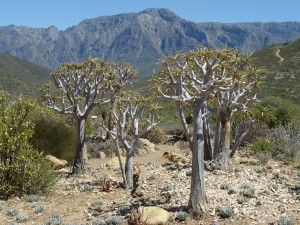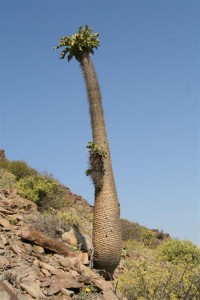Off to the Land of Oz
January 11th, 2011
No place on Earth has more botanic diversity and more wild, intriguing and flat-out weird plants than South Africa.
At least that’s what I’ve heard and read.
I remember York College professor Marilyn Daly telling me once after coming back from a trip there that it was like being in the Land of Oz.
I don’t know if I’ll see the Wizard or not, but I’m off today for a 17-day “garden safari” to South Africa. Harrisburg Area Community College and AAA put it together, and I’m leading a group to see if we can spot a baobab or see a king protea in its native habitat.
A baobab is an oddball tree that looks like it’s been planted upside-down. The canopy drops its leaves in summer to show a bare structure that looks more like roots than branches.
It also produces edible gourd-like fruits that monkeys love.
King protea is South Africa’s national flower. These things are huge, colorful and look a little like upward-facing sunflowers, only more elegant and crown-like. Here’s a picture. It’s hard to describe.
Proteas grow as shrubs and are prized as cut flowers, which is probably how you’ve seen them – if you ever have.
I’m also really curious to see a halfmens. These are succulents that grow as tall as trees but look like giant baseball bats stuffed upside down into the ground with a mop of green hair growing at the top. Weird. Even Dr. Seuss didn’t come up with something this odd-looking.
Not all the plants are that wild, though. South Africa is home to a ton of plants we routinely grow that we don’t even know are South African natives.
Take the red geranium that just about all central Pennsylvanians have grown in a flower pot. Its purplish mother is from South Africa.
Gazanias, red hot pokers, diascia, hardy ice plants, calla lilies, agapanthus, arum lilies, cape daisies, bacopa, nemesia, purple hyacinth beans, clivia, crocosmia, plectranthus, nerine and many aloes, gladiolus and gardenias are all just some of the annual and perennial flowers that we grow in the U.S. that hail from South Africa.
I suspect we’ll continue to see more, given that this horticultural wonderland is blessed with some 20,000 different plant species.
One of the best parts about South Africa is that their seasons are opposite ours, which means it’s summer in January there. It’s pretty dry, though, although the summer highs typically run into the 80s and not the 100 or so that we hit this past summer.
We’ll be visiting the world-renowned Kirstenbosch Botanic Garden the first day there, then hitting three more major public gardens in addition to seeing the fynbos (the cape’s native vegetation), the beautiful coastal Garden Route, a forested region along the southern cape and a game park in the northeastern part of the country (Kruger National Park). Last stop is a side trip to Victoria Falls in Zambia.
It all sounds incredible to me. I’ve never been anywhere near any of that. I’m sure I’ll know I’m not in Mechanicsburg any more when I come face to face with a wildebeest.
I’ll also check out which way the water swirls down the toilet (I hear it goes the other way in the Southern Hemisphere), and I’m hoping to run into the Cape Town baboon that supposedly walks into people’s unlocked homes, raids their refrigerators, then closes the door on the way back out.
Like I say, interesting country. The only part I’m not looking forward to is the 24 hours on three different planes just to get there.










